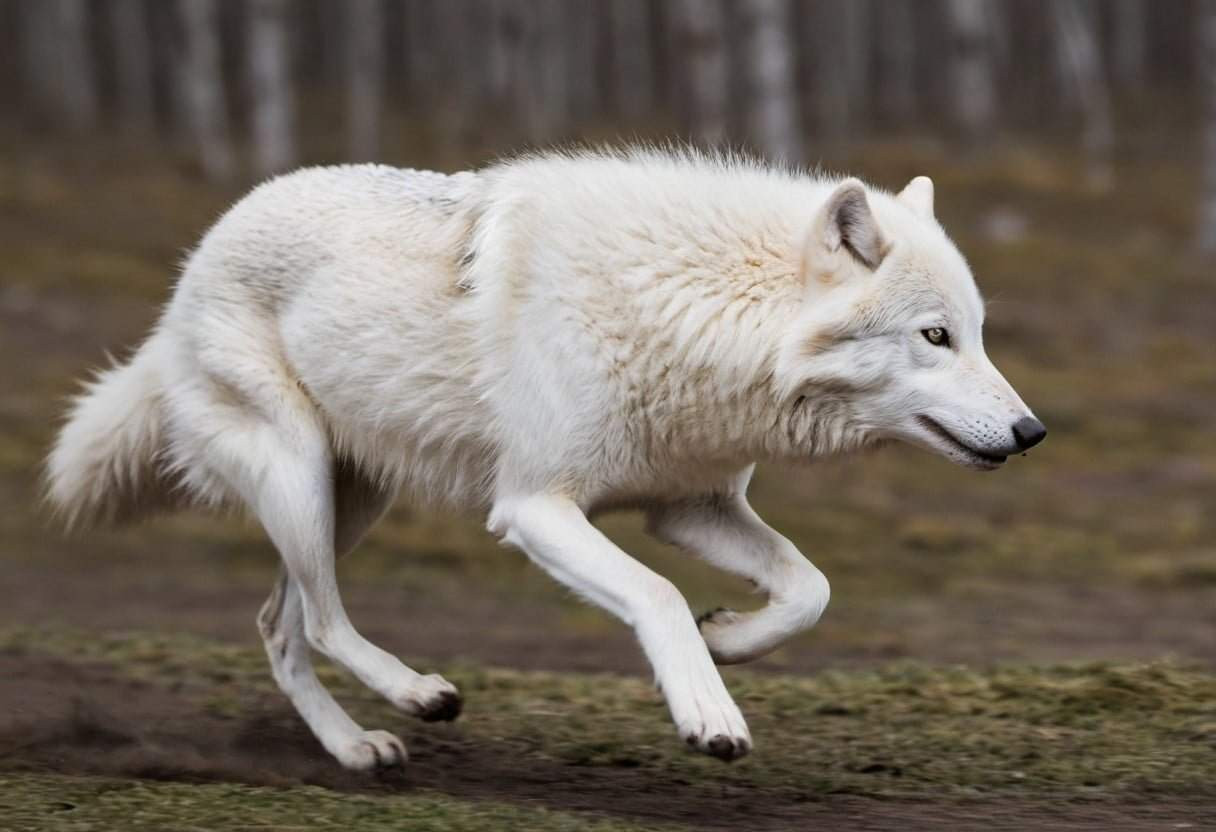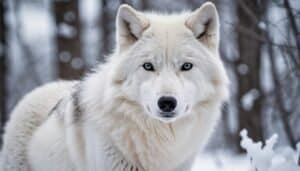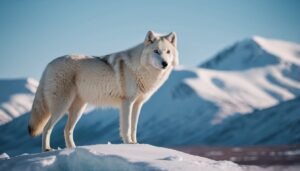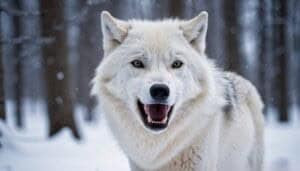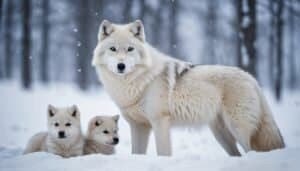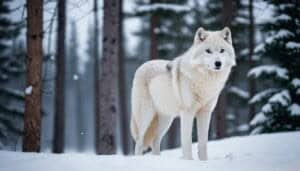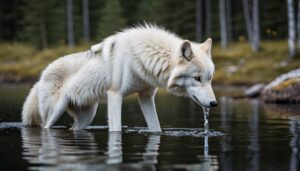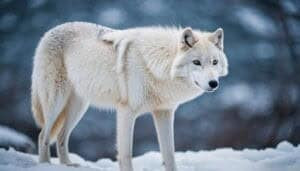Introduction
Understanding how the Arctic wolf’s cardiovascular system supports its remarkable endurance offers insight into how these animals thrive in such harsh environments
This article will explore the key components of their cardiovascular system, its specific adaptations, and how it interacts with other systems to maintain stamina and health. We will also look at comparisons with other wolf species and the impact of aging on their cardiovascular health
Key Components of the Arctic Wolf’s Cardiovascular System
Heart
The heart of the Arctic wolf, like that of other mammals, is a powerful muscular organ responsible for pumping blood throughout the body. It has four chambers: two atria and two ventricles, which work together to ensure a continuous flow of oxygen-rich blood to the tissues and oxygen-poor blood to the lungs for reoxygenation
The Arctic wolf’s heart is adapted to its active and often strenuous lifestyle. It can increase its rate and output significantly during physical exertion, such as hunting or escaping predators, to meet the heightened demand for oxygen and nutrients by the muscles
Blood Vessels
Blood vessels, including arteries, veins, and capillaries, form an extensive network throughout the Arctic wolf’s body. Arteries carry oxygenated blood away from the heart to the tissues, veins return deoxygenated blood back to the heart, and capillaries, the smallest blood vessels, facilitate the exchange of oxygen, carbon dioxide, and other nutrients at the cellular level
The elasticity and robustness of the arteries in Arctic wolves are particularly notable, as they must withstand and regulate the high pressures generated by the heart during intense activities. Veins are equipped with valves that prevent backflow and ensure efficient return of blood to the heart
Blood Composition
The blood of the Arctic wolf is rich in hemoglobin, the protein responsible for oxygen transport. Hemoglobin’s affinity for oxygen is critical, as it allows the blood to carry large quantities of oxygen from the lungs to the muscles and other tissues, supporting prolonged physical activity
Additionally, Arctic wolves have a higher red blood cell count compared to many other animals, enhancing their blood’s oxygen-carrying capacity. This adaptation is particularly advantageous in the oxygen-scarce, cold environments where they live, ensuring that their tissues remain well-oxygenated even in extreme conditions
Function and Role in Endurance
Heart Rate and Cardiac Output
The heart rate and cardiac output of the Arctic wolf are highly variable and can adjust according to the wolf’s activity level. During periods of rest, the heart rate slows down to conserve energy. However, during hunting or escaping from threats, the heart rate can increase dramatically, enhancing cardiac output to meet the elevated metabolic demands
Cardiac output is the volume of blood the heart pumps per minute and is a critical factor in maintaining endurance. The ability of the Arctic wolf’s heart to sustain high cardiac output during prolonged exertion is key to its stamina and survival in the wild
Blood Vessels: Arteries, Veins, and Capillaries
Arteries play a crucial role in delivering oxygen-rich blood to the muscles, especially during physical exertion. Their elasticity allows them to expand and contract with each heartbeat, helping to maintain blood pressure and flow
Veins, equipped with one-way valves, facilitate the return of deoxygenated blood to the heart, preventing backflow and ensuring efficient circulation. Capillaries, being the site of nutrient and gas exchange, are essential for delivering oxygen directly to muscle cells and removing metabolic waste products like carbon dioxide
Blood Composition: Hemoglobin Levels and Oxygen Transport
High levels of hemoglobin and a dense population of red blood cells enable Arctic wolves to transport and utilize oxygen efficiently. Hemoglobin binds oxygen in the lungs and releases it in the tissues where it is needed most, particularly during sustained physical activities such as long-distance travel and hunting
This efficient oxygen transport system allows Arctic wolves to maintain high levels of aerobic metabolism, crucial for their endurance. The increased oxygen availability supports sustained muscle activity, preventing fatigue during prolonged exertion
Adaptations for Cold Environments
Insulation and Blood Flow
The Arctic wolf’s cardiovascular system is intricately linked to its ability to survive and thrive in extremely cold environments. One key adaptation is its highly efficient insulation. Arctic wolves have thick fur and a layer of fat beneath their skin that helps to conserve body heat
This insulation reduces the amount of energy their cardiovascular system needs to expend on maintaining body temperature, allowing more energy to be directed towards physical activity and endurance
Additionally, the blood vessels in an Arctic wolf’s extremities, such as the legs and paws, have specialized adaptations to prevent heat loss. The arteries and veins are closely aligned, allowing for a counter-current heat exchange system
Warm blood flowing from the heart in the arteries warms the cooler blood returning from the extremities in the veins. This system minimizes heat loss and keeps the core body temperature stable, even in freezing conditions
Energy Conservation
Energy conservation is vital for Arctic wolves, especially given the scarcity of food in their harsh environment. The cardiovascular system plays a significant role in this aspect by optimizing the distribution of oxygen and nutrients. During periods of rest, the heart rate and metabolic rate drop, reducing overall energy expenditure
Moreover, Arctic wolves have adapted to be able to survive on a low-calorie diet for extended periods. When food is scarce, their bodies can switch to metabolizing fat reserves, which are more energy-dense compared to carbohydrates and proteins
This metabolic flexibility is supported by their cardiovascular system, which efficiently delivers the necessary nutrients and oxygen to sustain prolonged periods of low activity followed by sudden bursts of high activity during hunting
Muscular and Cardiovascular System Relationship
Muscle Efficiency and Oxygen Supply
The relationship between the Arctic wolf’s muscular and cardiovascular systems is crucial for their endurance and overall survival. Their muscles are composed of a high percentage of slow-twitch muscle fibers, which are more efficient for sustained, aerobic activities compared to fast-twitch fibers that are used for short, explosive bursts of power
These slow-twitch fibers are rich in mitochondria, the cellular structures responsible for aerobic energy production. This high mitochondrial density ensures that the muscles can utilize oxygen effectively, which is supplied by the well-adapted cardiovascular system
The combination of efficient oxygen delivery and high mitochondrial activity allows Arctic wolves to sustain long-distance travel and prolonged physical exertion without quickly depleting their energy reserves
Oxygen Supply
Oxygen supply is the cornerstone of the Arctic wolf’s endurance. Their cardiovascular system ensures a constant and ample supply of oxygen to the muscles, even during intense physical activity
The large lung capacity of Arctic wolves enhances their ability to intake and utilize oxygen. This oxygen is then transported efficiently by the high hemoglobin levels in their blood to the muscles where it is most needed
During a chase, for instance, the Arctic wolf’s heart rate can increase dramatically, boosting cardiac output and the delivery of oxygenated blood to the muscles. This increased oxygen supply supports aerobic metabolism, which is more sustainable and efficient for prolonged activity compared to anaerobic metabolism, which quickly leads to fatigue and the buildup of lactic acid
Hunting Strategies and Cardiovascular Support
Sprinting vs. Endurance
Arctic wolves employ a combination of sprinting and endurance in their hunting strategies. While they are capable of short bursts of high speed to catch prey, their primary strategy involves endurance
They can travel vast distances, sometimes over 30 miles in a day, to locate and pursue prey. This endurance is directly supported by their cardiovascular system, which provides a steady supply of oxygen to the muscles during these long hunts
Stalking and Pouncing
When hunting, Arctic wolves often use stalking techniques to approach their prey stealthily. This requires a significant amount of energy conservation and strategic bursts of speed. The cardiovascular system supports this by regulating heart rate and blood flow according to the immediate needs of the hunt
During the final pounce, the heart rate spikes, and the cardiovascular system works at peak efficiency to support the rapid movement and strength needed to capture and subdue the prey
Comparisons and Environmental Impact
Comparison with Other Wolf Species
When compared to other wolf species, such as the grey wolf or red wolf, the Arctic wolf shows unique cardiovascular adaptations that support its endurance and survival in cold environments
Grey wolves, for instance, live in more temperate climates and do not require the same level of cold-specific adaptations. Their cardiovascular systems are similarly efficient but optimized for different environmental challenges
Impact of the Arctic Environment on Cardiovascular Health
The harsh Arctic environment places significant demands on the cardiovascular health of Arctic wolves. Extreme cold, scarcity of food, and the need for constant movement to find prey all impact their cardiovascular system
However, their unique adaptations, such as efficient blood flow mechanisms and the ability to maintain core temperature, help mitigate these challenges and maintain cardiovascular health
Changes with Age
Aging and Endurance
As Arctic wolves age, their cardiovascular system undergoes changes that can impact their endurance. Older wolves may experience a decrease in heart rate variability and cardiac output, which can reduce their ability to sustain prolonged physical activity
Additionally, the elasticity of blood vessels may decrease with age, affecting blood flow efficiency
Health Implications
Age-related changes in the cardiovascular system can also lead to an increased risk of health issues such as cardiovascular disease. However, the natural selection process in the wild ensures that only the healthiest and most adaptable wolves survive to old age
These older wolves often rely more on their experience and strategic hunting skills to compensate for any decline in physical endurance
Conclusion
The Arctic wolf’s cardiovascular system is a marvel of adaptation, perfectly suited to support endurance in one of the planet’s harshest environments. Key components such as the heart, blood vessels, and blood composition are fine-tuned to ensure efficient oxygen and nutrient delivery, crucial for sustained physical activity
The heart’s ability to regulate rate and output in response to activity levels, along with the specialized structure of blood vessels, underscores the system’s role in maintaining stamina
Adaptations like counter-current heat exchange in blood vessels and efficient energy conservation mechanisms enable Arctic wolves to thrive in freezing conditions. The relationship between the cardiovascular and muscular systems ensures that oxygen supply meets the demands of prolonged activity, crucial for hunting and survival
Comparisons with other wolf species highlight the unique features of the Arctic wolf’s cardiovascular system tailored to extreme cold
Environmental factors and aging bring additional challenges, but the cardiovascular system’s resilience and efficiency help mitigate these impacts. Through a combination of physiological adaptations and strategic behaviors, the Arctic wolf maintains its endurance and health throughout its life, exemplifying the remarkable interplay between biology and environment in sustaining life in the Arctic tundra
